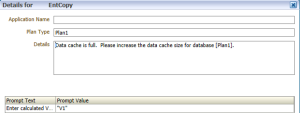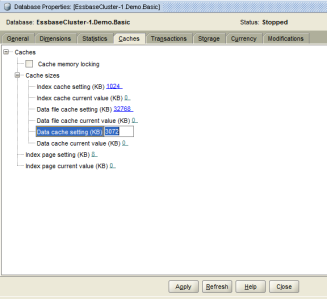Archive for June 2014
Originally posted on The I.T. Side
Now with Oracle Cloud EPM, you just need from $120/month/user for at leasts 10 user to have most of Oracle EPM advantages.
—————————————–
Yes you can afford Oracle EPM – how to get started for less.
Let’s face it, implementing Oracle software can be an expensive undertaking. After doing some quick analysis, many companies who desperately want to get out of the spreadsheet rat-race feel over burdened with the perceived high cost implementing an enterprise solution for performance management. No company is adverse to spending money if it will yield a worthwhile return. But if you are new to EPM, getting a handle on the overall ROI with EPM and BI can be challenging.
- What value will the EPM solution bring?
- What cost savings will be realized as a result?
- What quality will be improved?
- What risks will be reduced?
- How much time will be saved?
Of course, the flip side to this is cost.
Let’s break down the major cost factors for an EPM implementation, outline some considerations for each, and identify opportunities to reduce cost.
1.) Software Licensing and support
Most Oracle EPM modules are priced by the number of application users and can be thousands of dollars per user. There is also the cost of support which entitles you to software updates.
Oracle’s pricing list is here
http://www.oracle.com/us/corporate/pricing/price-lists/business-intelligence-price-list-071347.pdf
Considerations:
Oracle EPM software pricing can be done with a suite of products that come with many popular modules and the ability to add on options. You can also purchase each individual product standalone.
The way to save:
- Every product has a minimum number of users you must purchase. Organizations just getting started in EPM could consider the minimum user license for now, you can also add more users later.
- Only buy what you need. Many times the all-in-one suites have many modules you do not need. Perhaps looking at a standalone module would be best to start with and add on as needed.
- Many organizations split the cost between multiple organizational divisions to help reduce the burden to the individual cost centers.
- Implement a phased approach. Implement one module at a time, for a core group of users, then expand.
Where we can help:
We can perform a full assessment of your overall EPM, BI, and reporting vision to assist you in software selection, capabilities, and add-ons you need, identify phases, and ascertain overall cost and ROI. We can also help in your negotiations with Oracle, and even help you write an RFP if you want to send it out for bid.
2.) Hardware
While software licensing costs can be somewhat straight forward, often times hardware costs can be a black box. Understanding all the necessary servers, network equipment, disk storage, required third party software, etc. can be daunting to the point of giving up. However, this information is simply mandatory to adequately cost out your project.
- Operating System cost
- Server cost – based on required CPU, Memory
- Disk Storage
- Required third party software such as Oracle database or SQL Server.
Considerations:
There are many factors that will influence what is required for hardware. The number of environments, users, uptime/availability requirements, and understanding what internal technology that can be leveraged such as pre-existing Storage Area Networks. The only way to know for sure is to have a professional hardware design performed.
The way to save:
- Consider cheaper operating systems, such as Linux.
- Consider virtual machines to lower the physical hardware footprint.
- Only buy what you need. Consider starting with only a DEV and PROD for now.
How we can help:
We perform a standard one-day hardware design session with your organization to completely understand the use case, modules, scalability, security needs, service level needs, etc. It is a very quick and inexpensive offering that can prevent a lot of budget surprises.
Still too expensive? Have us deal with it for you.
We also offers Oracle EPM and BI server hosting. Using our cloud hosted services, organizations save big time by eliminating the large cost of servers (That have to be replaced every few years). Also eliminated is the infrastructure space, electricity, etc. Our hosting service provides:
- Secure high-speed access to servers over secure VPN – the servers look like they are directly on your network, so data integration is a snap.
- Full high-availability fault tolerance.
- Full data center disaster recovery with geo-redundant storage.
3.) Software development and training
The possibilities with the Oracle EPM stack are seemingly infinite. However, it has to be developed. The installation creates a blank canvas and it needs to be developed and configured which takes time, money, and know-how.
Considerations:
Even the smallest greenfield implementation will undergo these major steps:
1.) Design/AssessmentDimensionality, reporting, data integration, etc.2.) ImplementationConfigure the software to the design
3.) Testing
Conference Room Pilots, User Acceptance Testing, etc.
4.) Training, documentation
User and Admin training
5.) Roll-out
Go-live, parallel close cycles,
6.) Expand
Adding additional functionally, users, divisional units, detail, modules, etc.
The way to save:
- Implement a phased approach. Start with one module, one application, and simple reports. Go-live and get user acceptance, then expand capabilities.
- Use an implementation partner to train your people so that they can continue with the application development, reports, etc.
How we can help:
We have dedicated rapid deployment programs specifically for midsize companies seeking to get up and running fast. We have fast tracks for rapidly deploying Business Intelligence (OBIEE), Planning, Financial Management, and Data Relationship Management. This program is perfect for those that want start their journey away from Excel and embrace an enterprise solution as a quick win first step. The scope is clear, implementation is quick, with detailed training and documentation throughout.
4.) Ongoing administration, support.
Just like all enterprise system, this is not a set-it-and-forget-it solution. Oracle EPM requires ongoing administration and support both functionally and from IT.
- Data and metadata loading
- Calculations, aggregations, consolidations
- User access issues
- Server maintenance and troubleshooting
- Backups
- Patching
- Monitoring
Considerations:
This typically involves many people. While it may not be a full time job for any one individual, it does involve many skill sets. Functional admin users are usually the first line of support for issues. Technical issues could easily involve server admins, database admins, network admins, etc. Most importantly, someone needs to create, maintain, monitor, and test backups and recovery procedures.
The way to save:
Ensure you are working with a partner that takes administration and IT training seriously. Properly spending time training admins up front will significantly save time and money in the long run.
How we can help:
We offer all sorts of training including administration training and dedicated IT training covering proper maintenance, troubleshooting, logging, backup/recovery, architecture, scalability, tuning, etc.
If you are understaffed – have no fear. No need to go out and hire full time people, we offer worry-free Managed Services and Helpdesk services for companies of all sizes. For midsize companies getting started in EPM, we offer a low-cost basic package for Helpdesk services; including a fully functional web based ticketing system and 15 minute service-level ticket acknowledgment from our knowledgeable on-shore Helpdesk team. This service can save you 60-70% in overall costs associated with day to day maintenance and support costs. For companies wanting more IT services, our fast reacting helpdesk can do ongoing proactive health monitoring, job monitoring, backups, tuning, patching, etc.
Summary
It’s obvious that there many possibilities to implement EPM. Whether you are looking start a new EPM project, reduce costs of your current implementation, upgrade, improve support, etc…. it all starts with discovery workshop. We will help you justify your ROI, calculate costs, and go over all your options to ensure you are not overbuying, over allocating, or inaccurately budgeting.
It is possible to start your journey to EPM on almost any budget. Contact me for more information on how to get started.
New Oracle EPM Infographic…
Posted on: June 26, 2014
So Cloud, mobility, big data leverage are the most popular trends for 2014
Everyone should see yourself on this 😀
All about Essbase Data Cache
Posted on: June 16, 2014
If you have already been a Hyperion Planning consultant long enough, you should have met this issue sometimes: “Data cache is full. Please increase the data cache size for database…”
Of course our first thought to solve this problem is to increase the data cache size for database like what the instruction said. And below is how:
OK, but how much the data cache should be for best practice? You can read this http://docs.oracle.com/cd/E12825_01/epm.111/esb_dbag/dstcache.htm#dstcache1010002
By default, it’s just 3072 KB. So if you keep increasing the cache but you still have this issue, it’s time for you to think about your business rule or even your design. Because the more memory you allocate for data cache, the more RAM essbase will take over permanently (never release even the rule has already finished) unless you restart the Essbase app/cube.
Once Essbase pulls a block into memory, it won’t release it unless the app is stopped, or there is no additional memory available, and it has to release the block so it can go get another block. So Essbase won’t really “release” the memory. This is one reason Essbase has a reputation for not playing nicely with other applications on the same server (like relational databases).
http://www.network54.com/Forum/58296/thread/1167930858/Releasing+memory
What need a lot of Data Cache usually are those calculation need the participating of a lot of member/data such as aggregation. For example:
FIX (Year1, Year2, Year3)
CALC DIM (Entity, Product, Customer, Currency, Period).
// To aggregate the parent, it’s needed to load all the children to Cache to perform the aggregation
ENDFIX
The above rule aggregates most of dimensions so it may need the whole cube load into Cache to perform calculation. To solve this issue either you can try to break the rule in to parts:
FIX(Year1)
CALC DIM (Entity, Product, Customer, Currency, Period).
ENDFIX
FIX(Year2)
CALC DIM (Entity, Product, Customer, Currency, Period).
ENDFIX
…
Or thinking about a way to make your block size smaller…. depend on specific situation.
I’m not sure how accurate this analysis is because I have never tried other products but Oracle. But this analysis really gave a good insight on EPM/CPM products available in market. Download the file below for more detail:
Recently, there is Anaplan, a excel-like PBF solution on cloud which has just raised $100M is not mentioned in this analysis.





Recent Comments